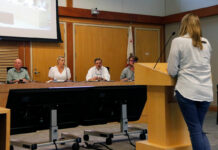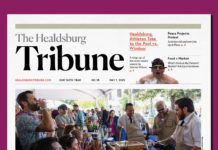Ceremonies are being held across America this year to commemorate the 50th anniversary of the Vietnam War to “thank and honor” veterans and to allow for public reflections on a time and war that seems very distant from the country we live in today.
Last week, just such a ceremony was held at the Pacific Coast Air Museum at the county’s Charles M. Schulz Airport. Dozens of Vietnam-era vets turned out, many with proud family members in tow. It was a solemn and small affair, with minimal military flare but abundant camaraderie.
No old wounds or debates were opened over what is now recognized as the “most unpopular (foreign) war in U.S. history.” Public comments reminded everyone that “honoring the warriors” can be different than “supporting the war.”
America’s Vietnam War officially began in March 1965 when Congress ratified the Tonkin Gulf Resolution, commencing strategic air strikes over North Vietnam. The first 5,000 U.S. troops were deployed, peaking at 543,482 by 1968. In all, three million men and women served during the war that officially ended in 1975. Over those years there were 58,253 U.S. soldiers killed. As many as three million Vietnamese on both sides of the war also were killed. And, 1,638 U.S. soldiers never came home, still counted as Missing In Action (MIA).
Also missing in action, 50 years later, are the harder lessons and any final answers to this war that shattered America, visited violent protests to our streets and college campuses and still leaves us in a state of post traumatic stress and moral injury.
We want to honor all those who served our country’s calling. We want to take back our words of “baby killers” and we want our leaders today to say “never again.” But we’re not ready yet.
Our post Vietnam traumatic stress is not cured. We continue to deny our battlefield defeat. We are loath to admit that we were the enemy.
Since the war’s end, our nation has tried to answer our divide between honoring our warriors but denouncing the war. Why did we spend $150 billion on weapons and warfare in the jungles of Southeast Asia? Why did 58,253 names get etched on the black granite wall in Washington, D.C. and another 153,363 soldiers come home wounded or broken forever? Why?
The whole world was different 50 years ago. Just a few years after the Cuban Missile Crisis in 1962, our country’s leaders feared Communist aggression. Red China was just waking up as a new world power and we were still trying to win a Cold War against the Soviet Union. The United States of America was the most powerful and respected nation in the world.
But the Vietnam War changed all that and we still can’t bring ourselves to answer how or why.
Vietnam was the war that both Buddhist monks and American Jesuits killed themselves in protest to stop. It was a war where we did kill babies, at My Lai and other innocent villages. But our trauma and horror is also filled with images of our own mud-covered infantrymen, at Con Thien, Da Nang or Khe Sanh, fighting like heroes and courageous warriors.
Fifty years ago, we were an America at war with itself. The same year we started bombing North Vietnam, the black population of Watts in Los Angeles burned down their own neighborhood to protest police brutality and landlord abuses. National Guardsmen shot and killed four anti-war protest students at Kent State. Fifty years ago, we fought over the symbol of a flag — not a Confederate flag but the U.S. flag. It was burned and hung upside down while it was waved proudly in VFW parades and on a thousand window decals that said “Love It or Leave It.”
Most of us, including the war’s veterans, aged anti-war protesters and our current Pentagon and Congressional warlords, will never know all the lessons and answers from the Vietnam War.
That’s what the Buddhists and Jesuits were trying to tell us a long time ago.
— Rollie Atkinson








